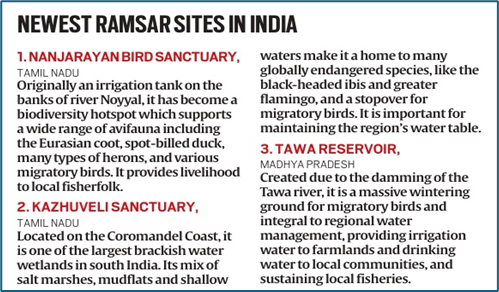Why in news?
Three new wetlands have got the Ramsar site tag taking the total tally of Ramsar wetlands to 85 in India. The three new Ramsar sites are Nanjarayan Bird Sanctuary and Kazhuveli Bird Sanctuary in Tamil Nadu and Tawa Reservoir in Madhya Pradesh.
What’s in today’s article?
- Wetlands and their significance
- Ramsar sites
- India adds 3 new Ramsar sites
What are Wetlands?
- About
- Wetlands are areas where water covers the soil or is present at or near the surface, creating unique ecosystems.
- The Ramsar Convention on Wetlands defines wetlands as areas that can be natural or artificial, permanent or temporary, where water may be static or flowing, and can be fresh, brackish, or salty.
- This includes marshes, fens, peatlands, and even shallow marine waters up to six meters deep at low tide.
- The definition emphasizes the diversity of wetland types, covering various water conditions and both inland and coastal ecosystems.
- Significance
- Wetlands help regulate climate conditions through carbon sequestration, that is, carbon storage from the atmosphere.
- According to the US Environmental Protection Agency, wetlands are among the most productive ecosystems in the world, comparable to rainforests and coral reefs.
- They play a crucial role in maintaining biodiversity, regulating water cycles, and acting as natural water purifiers.
- In India, wetlands like the Sundarbans in West Bengal and Chilika Lake in Odisha provide critical habitats for wildlife, support livelihoods through fishing and agriculture, and help in flood control, making them vital for environmental and economic stability.
- Wetlands in India
- In India, wetlands are spread over 15260572 square kilometres (sq km) which is ~4.63 per cent of the total geographical area of the country.
- Of this area, inland-natural wetlands account for 45 % and coastal-natural wetlands 25%.
- State-wise distribution of wetlands showed that Lakshadweep has 96.12% of geographic area under wetlands followed by Andaman and Nicobar Islands (18.52%), Daman and Diu (18.46%) and Gujarat (17.56%), have the highest extent of wetlands.
- Steps taken by India to protect wetlands
- The Indian government has launched a series of policies and initiatives to protect wetlands, like the National Wetland Conservation Programme of 1986 and the 2015 National Plan for Conservation of Aquatic Wetlands.
- The Ministry of Environment, Forest and Climate Change has also identified over 2,200 wetlands for conservation schemes.
What are Ramsar sites?
- About
- The Ramsar Convention, formally known as the Convention on Wetlands, is an international treaty established in 1971 in the Iranian city of Ramsar.
- Its primary goal is to conserve and sustainably use wetlands, which are vital ecosystems that provide numerous ecological, economic, and cultural benefits.
- The Convention encourages the designation of "Ramsar sites," which are wetlands of international importance due to their unique ecological characteristics.
- Member countries are obligated to maintain the ecological character of these sites and promote their sustainable use.
- Members
- Organisations like the International Union for Conservation of Nature, the World-Wide Fund for Nature, and other environmental agencies are associated with the treaty.
- It also has 172 signatory countries.
- Criteria
- The selection of Ramsar sites is based on various criteria defined under the convention.
- For example, “A wetland should be considered internationally important if it supports plant and/or animal species at a critical stage in their life cycles, or provides refuge during adverse conditions.”
- It also looks at the sites’ capacity to support fishes and waterbirds.
- Ramsar and India
- India joined it in 1982, initially designating the Chilika Lake in Orissa and Keoladeo National Park in Rajasthan.
- Today, the country has among the highest number of Ramsar sites in Asia.
India adds 3 new Ramsar sites

- Nanjarayan Bird Sanctuary
- Located on the banks of the Noyyal River, it was initially a water reservoir for irrigation but has evolved into a crucial ecosystem.
- It supports diverse bird species, including the Eurasian coot, spot-billed duck, and various herons, and attracts migratory birds along the Central Asian Flyway.
- The wetland is now a biodiversity hotspot and supports local livelihoods through fishing.
- Kazhuveli Sanctuary
- Situated on the Coromandel Coast, it is one of the largest brackish water wetlands in south India.
- The ecosystem i’s mix of salt marshes, mudflats and shallow waters make it a home to many globally endangered species, like the black-headed ibis and greater flamingo.
- It is also a stopover for migratory birds along the East Asian-Australasian Flyway.
- In storing water, Kazhuveli also helps with flood control and groundwater recharge, helping maintain the region’s water table.
- Tawa Reservoir
- It is integral in regional water management.
- Created by damming the Tawa River, the reservoir became a massive wintering ground for migratory birds.
- Tawa provides irrigation water to farmlands, drinking water to local communities, and sustains the nearby fisheries.










